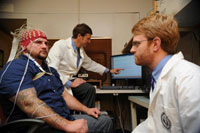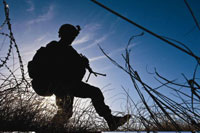Office of Research & Development |
 |



James Sperry, of Lebanon, Ill., considers himself lucky to be alive. In the fierce battle for Fallujah, Iraq, in 2004, a rocket-propelled grenade bounced off the Marine's Kevlar helmet.
Today, the 26-year-old Veteran is continuing to mend physically and emotionally. He is coping with mild traumatic brain injury and posttraumatic stress disorder—a dual diagnosis that affects many Veterans of the wars in Iraq and Afghanistan.
Many problems—such as lack of energy, trouble sleeping, irritability—occur in both conditions. In fact, the interplay between the two is highly complex; TBI damage to certain areas of the brain, for instance, could result in symptoms identical to those typical of PTSD, or affect a Veteran's ability to recover from emotional stress.
Sorting out which symptoms stem from TBI versus PTSD could aid treatment. Psychotherapy indicated for PTSD might not work as well when TBI is also present. Drug indications might change depending on the mix of symptoms.
Pinpointing the precise effects of TBI and PTSD on brain structure and function has thus become an important goal for researchers in VA and the Department of Defense. One such effort is under way at the Minneapolis VA Medical Center. A team led by Scott Sponheim, PhD, is working with up to 180 Minnesota National Guard troops who have come home from Iraq with mild TBI, PTSD, both conditions, or neither. The four-year study is looking at both brain structure and function, using neuropsychological tests plus two types of brain scans.
In the EEG (electroencephalography) phase of the study, participants wear a thin red nylon cap with dozens of electrodes attached, as they sit in a resting state or perform tasks involving attention, memory, and processing of visual or verbal information.
The researchers hope to be able to document key differences in the signals given off by TBI- versus PTSD-affected brains. For example, if their early data hold up, the investigators believe EEGs will consistently show less activity in the frontal lobes during memory tasks in those Veterans who have TBI, compared with those who have PTSD but no TBI.
To measure differences in brain structure, the researchers are using a form of MRI called diffusion tensor imaging. It shows abnormalities in the brain's white matter, the pinkish, fatty tissue whose glial cells and insulated axons relay messages throughout the brain. Here too, the researchers believe TBI-affected brains will reveal a signature pattern not seen in PTSD.
Once reliable biomarkers emerge for each condition, clinicians will have more evidence on which to base their diagnoses and therapy recommendations.